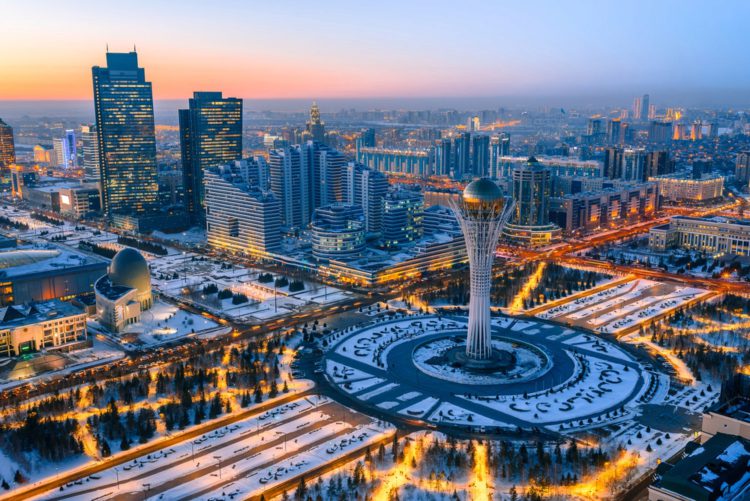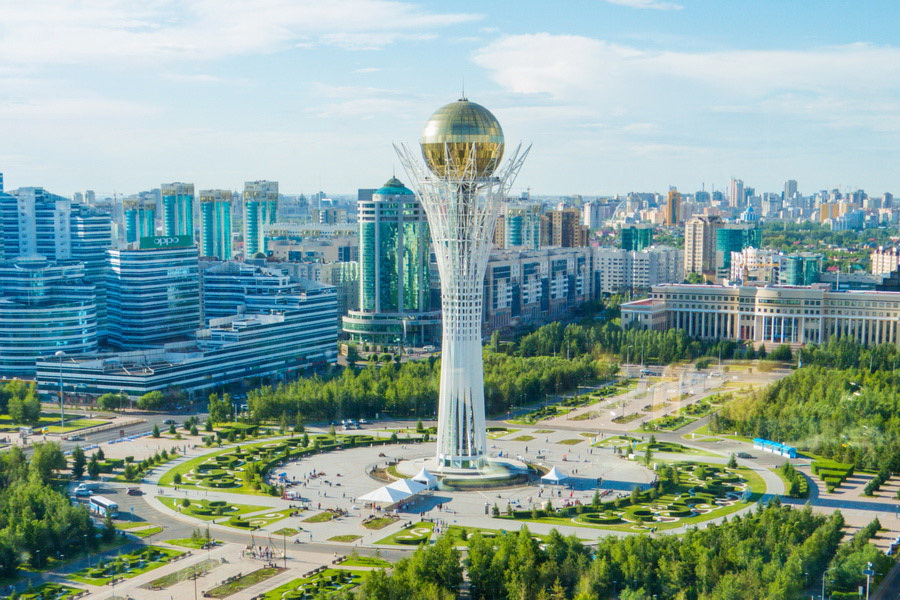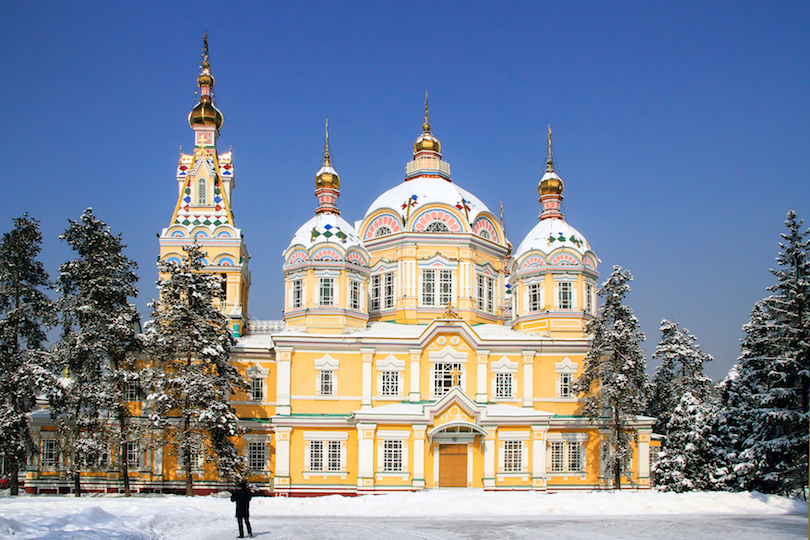
Kazakhstan, the ninth-largest country in the world, is a land of staggering contrasts and boundless beauty. Stretching from the Caspian Sea in the west to the Altai Mountains in the east, and from the Siberian plains in the north to the Central Asian deserts in the south, this vast nation defies easy categorization. It’s a place where ancient nomadic traditions intertwine with futuristic urban landscapes, where majestic natural wonders stand alongside Soviet-era relics and cutting-edge cosmodromes. For the intrepid traveler, Kazakhstan offers an adventure unlike any other – a journey through history, culture, and nature that leaves an indelible mark on the soul.
Once a vital artery of the ancient Silk Road, then a cornerstone of the Soviet Union, and now a vibrant independent republic, Kazakhstan is emerging as a compelling destination on the global stage. Its warm hospitality, diverse ecosystems, and rich heritage are drawing an increasing number of visitors eager to discover its hidden gems. This article delves into the top attractions, delves into its fascinating past, and provides essential travel tips to help you navigate this magnificent, often misunderstood, land.
Top Attractions: A Mosaic of Wonders

Related Articles about Kazakhstan: A Land of Nomadic Echoes, Cosmic Dreams, and Unforgettable Horizons:
- Ho Chi Minh City: A Journey Through Time, Culture, and Unforgettable Stays
- Finland’s Enchanting Embrace: A Guide to Its Best Hotels and Unforgettable Experiences
- Switzerland: A Symphony of Peaks, Lakes, and Timeless Charm
- Bulgaria: A Tapestry of Ancient Wonders, Natural Beauty, and Rich Culture
- Vietnam’s Enchanting Embrace: A Journey Through its Best Hotels and Unforgettable Experiences
Kazakhstan’s sheer size means its attractions are spread far and wide, each offering a unique glimpse into the country’s multifaceted identity.
1. Almaty: The Southern Capital of Culture and Nature
Nestled at the foot of the stunning Tian Shan mountains, Almaty is Kazakhstan’s largest city and its cultural heart. Formerly the capital, it retains a charming blend of Soviet-era architecture, leafy boulevards, and modern high-rises.
- Big Almaty Lake (Bolshoye Almatinskoye Ozero): A jewel of the Trans-Ili Alatau mountains, this vibrant turquoise lake changes color with the seasons and the angle of the sun. Surrounded by snow-capped peaks, it’s an ideal spot for hiking, picnics, and breathtaking photography, though swimming is prohibited as it’s a source of drinking water.
- Kok-Tobe Hill: Accessible by a scenic cable car, Kok-Tobe offers panoramic views of Almaty against the backdrop of the mountains. It features a TV tower, a small zoo, an amusement park, and the famous Beatles monument.
- Shymbulak Ski Resort: Just a short drive from the city, Shymbulak is a modern ski resort boasting excellent slopes and facilities. In summer, it transforms into a hiking paradise, with chairlifts offering access to higher mountain trails.
- Arasan Baths: Experience a traditional Central Asian banya (bathhouse) at Arasan. With separate sections for men and women, it offers steam rooms, saunas, and various spa treatments – a perfect way to relax after a day of exploring.
- Central State Museum of Kazakhstan: One of the largest museums in Central Asia, it houses an extensive collection spanning Kazakhstan’s history from ancient times to the present day, including archaeological finds, ethnographic exhibits, and artifacts from the Golden Man.

2. Astana (Nur-Sultan): The Futuristic Capital
Kazakhstan’s current capital, Astana (officially Nur-Sultan from 2019-2022, but commonly reverted to Astana by locals and government), is a dazzling testament to ambition and modern architecture. Rising from the northern steppe, it’s a city of gleaming skyscrapers, futuristic monuments, and grand boulevards.
- Bayterek Tower: The iconic symbol of Astana, this 97-meter-tall monument (representing the year of the capital’s relocation) offers a panoramic view of the city from its golden orb. Visitors can place their hand in the imprint of President Nazarbayev’s palm for good luck.
- Palace of Peace and Reconciliation (Pyramid): Designed by Norman Foster, this striking pyramid-shaped building is a venue for the Congress of Leaders of World and Traditional Religions, symbolizing interfaith harmony.
- Khan Shatyr Entertainment Center: Another Foster creation, this giant transparent tent is a shopping and entertainment complex, housing an indoor beach, mini-golf, and a monorail, all within a climate-controlled environment.
- Hazret Sultan Mosque: One of the largest mosques in Central Asia, its gleaming white marble, intricate patterns, and towering minarets are a magnificent sight, especially at sunset.
- National Museum of the Republic of Kazakhstan: A sprawling museum showcasing the country’s rich history, culture, and art, featuring impressive interactive displays and significant archaeological findings.
3. Turkestan: The Spiritual Heart of Kazakhstan
Located in the south, Turkestan is one of Central Asia’s oldest cities and a vital spiritual and historical site.
- Mausoleum of Khoja Ahmed Yasawi: A UNESCO World Heritage site, this magnificent unfinished mausoleum of a 12th-century Sufi mystic is an architectural masterpiece. Commissioned by Timur (Tamerlane) in the late 14th century, its intricate tilework, grand dome, and historical significance make it a pilgrimage site for Muslims across Central Asia.
4. Charyn Canyon: Kazakhstan’s Grand Canyon
Often dubbed the "Grand Canyon of Central Asia," Charyn Canyon is a spectacular natural wonder located about 200 km east of Almaty. Formed by the Charyn River, its dramatic red sandstone formations, particularly in the "Valley of Castles," create an otherworldly landscape. Hiking through its depths offers breathtaking views and a sense of awe.
5. Kolsai Lakes & Kaindy Lake: Emerald Gems of the Tian Shan
Nestled within the Northern Tian Shan mountains, the Kolsai Lakes are a cascade of three stunning alpine lakes renowned for their emerald green waters and pristine natural beauty. Further afield, the eerie Kaindy Lake is famous for its submerged forest, where the trunks of spruce trees rise eerily from the turquoise waters, a result of an earthquake-induced landslide in 1911. These lakes offer fantastic opportunities for hiking, horseback riding, and camping.
6. Tamgaly Petroglyphs: Ancient Art on Stone
Another UNESCO World Heritage site, Tamgaly is an archaeological treasure trove featuring thousands of ancient petroglyphs (rock carvings) dating from the Bronze Age to the medieval period. These intricate carvings depict animals, human figures, and ritual scenes, offering invaluable insights into the beliefs and daily lives of early nomadic tribes.
7. Altyn-Emel National Park: The Singing Dune and Martian Landscapes
This vast national park in the Almaty region is home to diverse landscapes, including the famous Singing Dune. When conditions are right, the wind blowing across this enormous sand dune produces a low, humming sound, earning it its mystical name. The park also features dramatic "Aktau" (White Mountains) and "Katutau" (Red Mountains), which resemble a Martian landscape with their colorful, stratified rock formations.
8. Baikonur Cosmodrome: Gateway to Space
For space enthusiasts, the Baikonur Cosmodrome offers a truly unique experience. This historic site, leased by Russia, is the world’s first and largest operational space launch facility. While access requires special permits and organized tours, witnessing a rocket launch from this legendary site is an unforgettable, once-in-a-lifetime event.
A Journey Through Time: Kazakhstan’s Rich History
Kazakhstan’s history is as vast and varied as its landscapes, shaped by millennia of nomadic migrations, powerful empires, and ideological shifts.
Ancient Roots and the Silk Road: For thousands of years, the steppes of Kazakhstan were home to various nomadic tribes, including the Scythians, Sakas, and Huns. These skilled horsemen left behind a rich archaeological legacy, including the "Golden Man" (a warrior clad in gold armor, discovered near Almaty). From the 2nd century BCE, the region became a crucial link in the Silk Road, facilitating the exchange of goods, ideas, and cultures between East and West. Cities like Taraz and Turkestan flourished as trade hubs and centers of learning.
Rise of the Kazakh Khanate: In the 15th century, various Turkic tribes united to form the Kazakh Khanate, marking the birth of the Kazakh nation. This period saw the development of a distinct Kazakh identity, culture, and language, characterized by a nomadic pastoral lifestyle and a strong oral tradition. However, the Khanate was often fragmented and faced external threats from neighboring empires.
Russian and Soviet Influence: By the 18th and 19th centuries, the Kazakh lands gradually came under the influence and then direct rule of the Russian Empire. This brought an end to the nomadic lifestyle for many and introduced Russian administration and culture. Following the 1917 Russian Revolution, Kazakhstan became a constituent republic of the Soviet Union in 1936. The Soviet era brought immense changes, including forced collectivization (which led to devastating famines), industrialization, and mass migration of other Soviet nationalities to Kazakhstan. The country also became a site for significant Soviet projects, such as the Virgin Lands Campaign and the Baikonur Cosmodrome, as well as nuclear testing at Semipalatinsk.
Independence and Modernity: With the collapse of the Soviet Union in 1991, Kazakhstan declared its independence. Under the leadership of its first president, Nursultan Nazarbayev, the country embarked on a path of economic reform, nation-building, and international engagement. The relocation of the capital to Astana in 1997 symbolized this new era of ambition and modernity. Today, Kazakhstan is a stable, multi-ethnic state actively pursuing economic diversification and a prominent role in Central Asian and global affairs.
Travel Tips for the Modern Explorer
Venturing into Kazakhstan requires some practical knowledge to ensure a smooth and enjoyable trip.
- Visa Requirements: Visa policies vary by nationality. Many Western countries, including the EU, USA, Canada, and Australia, enjoy visa-free entry for up to 30 days. Always check the latest requirements with the Kazakh embassy or consulate in your country before traveling.
- Language: Kazakh is the state language, but Russian is widely spoken and understood, especially in cities and among older generations. English is increasingly common in tourist areas, major hotels, and among younger people in Almaty and Astana, but learning a few basic Russian or Kazakh phrases will be highly appreciated.
- Currency: The local currency is the Kazakhstani Tenge (KZT). ATMs are widely available in cities, and credit cards are accepted in larger establishments. It’s always wise to carry some cash for smaller purchases, markets, and rural areas.
- Safety: Kazakhstan is generally a safe country for tourists. However, standard precautions apply: be aware of your surroundings, especially in crowded areas, and safeguard your belongings. Petty crime, like pickpocketing, can occur.
- Local Customs and Etiquette: Kazakh hospitality is legendary. Guests are highly valued. When visiting homes, it’s customary to bring a small gift. Dress modestly when visiting religious sites. Tipping is becoming more common in restaurants.
- Connectivity: Local SIM cards are affordable and readily available from providers like Kcell, Beeline, and Tele2. Data coverage is generally good in cities and along major routes.
- Health and Insurance: No specific vaccinations are mandatory, but routine vaccinations should be up-to-date. Travel insurance covering medical emergencies and evacuations is highly recommended, especially if you plan to explore remote natural areas.
- Water: It’s advisable to drink bottled water.
Accommodation Options: From Yurts to Luxury
Kazakhstan offers a diverse range of accommodation to suit every budget and travel style.
- Hotels: In Almaty and Astana, you’ll find a wide selection of international chain hotels (e.g., Ritz-Carlton, Hilton, Marriott) offering luxury and excellent service. Mid-range and budget-friendly local hotels are also abundant, providing comfortable stays.
- Guesthouses and Hostels: Particularly popular in Almaty, guesthouses offer a more local experience, often run by families. Hostels are a great option for solo travelers and those on a tighter budget, providing dormitory beds and opportunities to meet other travelers.
- Apartments: Short-term apartment rentals (via platforms like Airbnb) are a popular choice, especially for longer stays or groups, offering more space and self-catering facilities.
- Yurts: For an authentic nomadic experience, consider staying in a traditional yurt. Many tour operators arrange yurt stays in national parks like Altyn-Emel or near the Kolsai Lakes, offering a unique connection to Kazakh heritage and stunning stargazing opportunities.
Getting Around: Navigating the Vast Steppe
Navigating Kazakhstan’s vast distances requires a combination of transport methods.
- International Flights: The primary international gateways are Almaty International Airport (ALA) and Astana International Airport (NQZ), with direct flights from major cities in Europe, Asia, and the Middle East.
- Domestic Flights: Given the immense distances, domestic flights are the most efficient way to travel between major cities like Almaty, Astana, Shymkent, and Aktau. Air Astana (the national carrier) and FlyArystan (its budget subsidiary) offer reliable services.
- Trains: Kazakhstan has an extensive and generally comfortable rail network. Overnight trains, particularly the modern Talgo trains, are an excellent way to cover long distances while experiencing the country’s vast landscapes. Booking in advance is recommended.
- Buses and Marshrutkas: For shorter intercity routes and local travel, buses and marshrutkas (shared minibuses) are a budget-friendly option, though they can be less comfortable and slower than trains.
- Taxis: In cities, official taxis and ride-hailing apps like Yandex Go are widely available and affordable. Always agree on a fare or ensure the meter is running before starting your journey.
- Car Rental: While possible, renting a car for independent exploration, especially to remote natural parks, is often not recommended due to varying road conditions, language barriers, and challenging terrain. A 4×4 vehicle is essential for off-road adventures.
- Organized Tours: For reaching remote natural attractions like Charyn Canyon, Kolsai Lakes, or Altyn-Emel, organized tours are highly recommended. They handle transportation, guides, and logistics, allowing you to relax and enjoy the scenery.
Best Time to Visit: Embracing the Seasons
Kazakhstan experiences a continental climate with significant seasonal variations. The best time to visit largely depends on your interests.
- Spring (April-May): This is a beautiful time as the steppe awakens with wildflowers, and the weather is mild and pleasant. It’s ideal for city sightseeing, visiting national parks before the peak heat, and enjoying fewer crowds. However, some mountain roads might still be inaccessible due to snow.
- Summer (June-August): Summer is the peak tourist season, offering warm to hot temperatures across most of the country. It’s the best time for exploring the high mountains, hiking, camping, and enjoying outdoor activities. Cities can be quite hot, especially in the south.
- Autumn (September-October): Often considered one of the best times to visit. The weather is crisp and pleasant, the foliage in the mountains turns golden, and the harvest season brings fresh produce to markets. It’s excellent for both urban exploration and nature excursions.
- Winter (November-March): Winters are cold, with heavy snowfall, especially in the north and mountains. While challenging for extensive travel, it’s perfect for winter sports enthusiasts heading to Shymbulak. The snowy landscapes offer a stark and beautiful contrast, and the cities are quieter, with a festive atmosphere around the holidays.
Conclusion: A Land Awaiting Discovery
Kazakhstan is a land of profound contrasts and endless possibilities. From the soaring peaks of the Tian Shan to the futuristic skyline of Astana, from ancient petroglyphs to the launchpads of Baikonur, it offers a tapestry of experiences that challenge perceptions and inspire awe. It’s a country that embodies both the echoes of its nomadic past and the aspirations of a modern, forward-looking nation.
For those seeking an authentic adventure off the beaten path, a journey through Kazakhstan promises not just stunning landscapes and rich history, but also encounters with incredibly hospitable people and a culture that is both unique and deeply welcoming. Pack your bags, open your mind, and prepare to be captivated by the boundless horizons and unforgettable charm of Kazakhstan – a true gem of Central Asia, waiting to be discovered.





